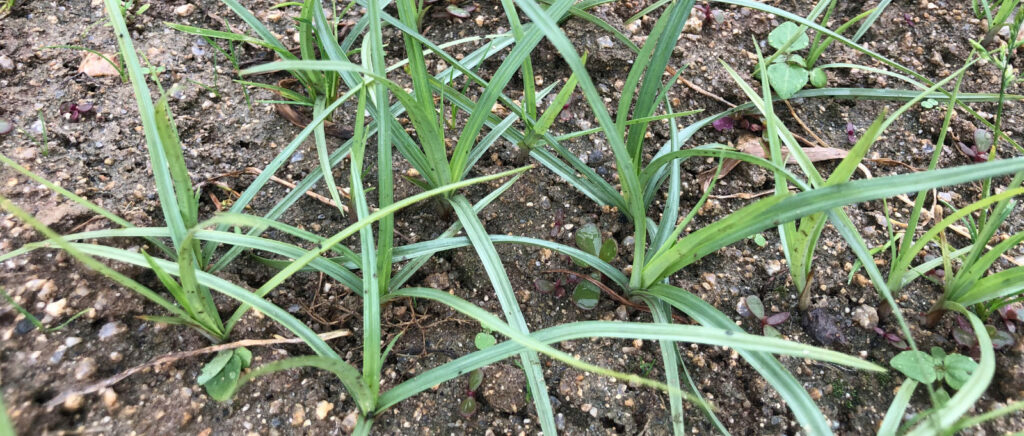Once again, welcome to our Novamulch agricultural section. This time, we’ll explore agricultural mulching. A widely used technique in various forms across all growing environments: organic, inorganic, degradable through industrial processes, and biodegradable in the field without leaving polluting residues, as is the case with Novamulch biodegradable paper mulch. Let’s begin.
What is agricultural mulching?

This is a technique used to manage soils prior to transplanting or sowing seeds. It involves covering the surface of the area to be cultivated with organic or inorganic material to condition and prepare it so that the microclimate and structure of the soil and the crop are better able to produce optimal results.
Origin and evolution of agricultural mulching.
The use of agricultural mulching is a practice that has left its mark since ancient times in different civilizations and cultures.
Around the 4th century BC, China and Japan documented the use of layers of rice straw and plant debris on their rice and tea crops to protect the root system from climatic and thermal fluctuations.
In the ancient Mediterranean and around the 1st century AD, in Greece and Rome the soil was covered with manure, leaves and branches to improve fertility and reduce evaporation, as described in documents of the time such as those of Lucius Junius Moderatus Columela (Gades, Baetica; 4th century AD/Tarento; ca. 70 AD), a Spanish agricultural writer from Ancient Rome, who left us, among others, his work De re rustica (The work of the field), in which he establishes some descriptions of everything related to agricultural practices common to that time.
Below we show more information that may be of interest to us:
https://es.wikipedia.org/wiki/Columela
In the highlands of pre-Columbian America, the Incas spread straw and plant fiber scraps over their arable soils to protect them from night frosts.
By the 19th century, the use of agricultural mulch had become a common cultivation technique throughout the world. The materials used continued to be organic, such as straw, hay, branches, and bark. Starting in the 1930s, manure and compost were once again systematically used as soil cover.
Around 1950, polyethylene plastic films were produced, revolutionizing agricultural mulching in the market. While it’s true that this invention reduced the proliferation of weeds and uncontrolled humidity in crops, it created a… greater evil? Yes, indeed. By not degrading and creating the need for periodic replacement crop after crop, polyethylene plastic continues to leave residues that are highly polluting for both the ecosystem and subsequent crops… and for our health…
This problem was a driving force behind the implementation of sustainable practices that were respectful of the environment and soil microbiota, and by the 1990s, the need arose to develop biodegradable alternatives for agricultural mulch to include in all planting projects.
Latest innovations in agricultural mulching.

Over the past two decades, agricultural research and environmental regulations have promoted the development of mulches that combine technical efficiency with a low environmental footprint. Let’s review.
On the one hand, plant fibers such as hemp, jute, and coconut are now processed and used in organic farming.
Likewise, compostable bioplastics such as PLA and PBAT are being created, two types of polymers used as a base for making compostable agricultural films. Both materials require industrial degradation processes because they do not fully integrate into agricultural soil. Let’s study.
PLA, Polylactic Acid:
It is a material obtained from renewable sources and is manufactured from corn starch, sugarcane, or beet.
Under industrial composting conditions, that is, at high temperatures and controlled humidity levels, PLA becomes biodegradable and compostable. It has good mechanical strength and transparency. It is often mixed with other polymers to improve flexibility. However, its biodegradation in soil at room temperature is slow, and it generally requires composting because its biodegradation is not fully achieved.
PBAT, Polybutylene Adipate Terephthalate:
This is a petrochemical-derived polyester designed to be biodegradable. It’s very flexible yet tear-resistant. It degrades more quickly under composting conditions, and in some cases, in agricultural soil.
It’s often blended with PLA to combine mechanical strength and degradability. Although it’s biodegradable, it’s partially derived from fossil fuels, so it’s not 100% renewable.
Novamulch biodegradable paper mulch.
Novamulch has also formulated a biodegradable paper mulch to remain in optimal condition throughout the entire crop cycle and in all types of environments, whether in open fields, greenhouses, domestic and urban gardens, terraces, balconies, and pots.
This material will not leave any polluting residues because at the end of the planting period, it biodegrades naturally, integrating into the soil as an excellent nutrient. It’s completely organic and therefore respectful of the microbiota and the environment. We’ll discuss this point in detail later.
Agronomic, economic and environmental benefits of agricultural mulch.

In its early days, agricultural mulching was an intuitive and empirical practice. Today, it is part of a comprehensive agronomic management system with very specific objectives:
- Optimize water efficiency and balance humidity levels.
- Regulate thermal variations in the soil.
- Reduce the use of non-organic herbicides.
- Control the proliferation of weeds.
- Improve fruit health by avoiding direct contact with the soil.
- Promote soil fertility and structure during crops and in the long term.
- Prevent erosion, compaction and leaching.
Applied properly, agricultural mulching is a technique that provides direct improvements in crop productivity, health, and sustainability. These benefits have been widely documented by agronomic studies and field experience in different climates and types of production.
Let’s now review these purposes for which agricultural mulching was designed.
Weed control.

Agricultural mulch produces a barrier effect; when spread beforehand over the crop surface, it prevents sunlight from directly hitting the soil, thus hindering the germination of unwanted seeds.
As a result of this barrier effect, competition for nutrients, water, and space will be minimized, favoring the development of our main crops.
Moisture conservation and water efficiency.
It reduces water evaporation and maintains balanced humidity levels for a long time, allowing for irrigation savings of approximately 20% to 50%.
However, this varies depending on the type of agricultural mulch selected, and climatic variables will also influence it, especially in areas with dry summers, where this material becomes a necessary tool to provide protection against water stress.
It’s important to note at this point that agricultural mulching prevents direct contact of water with the fruits and leaves of crops, thereby minimizing damage to this part of the plant structure.
Thermal regulation of the soil.
Agricultural mulch is a thermal insulator, as it is designed to prevent overheating during the day and excessive heat loss at night.
In spring, it warms the soil, promoting faster germination, and in summer it reduces average temperatures, protecting the root system.
Prevention of soil erosion, compaction and leaching.
It protects the soil surface from the direct impact of rain, preventing particle carryover and nutrient loss. It reduces the formation of surface crusts that limit water infiltration and gas exchange. It also maintains the soil structure in balance, promoting aeration and proper root development.
Improved fertility and biological activity.
Agricultural mulch, whether organic or biodegradable, provides organic matter and rich nutrients as it decomposes and integrates into the soil structure. It also facilitates the development of earthworms and beneficial microorganisms, which is vital for a crop habitat of optimal quality and yield.
Novamulch biodegradable paper mulch vs. conventional agricultural mulch. Comparative study.

This cultivation technique is currently used to achieve optimal and sustainable results in all agricultural projects, and organic materials such as straw, compost, and plant debris, as well as inorganic materials such as polyethylene, have always been used.
Now, with the growing need to use procedures that are consistent with the protection of our ecosystems and everything related to the sustainability of our natural resources, biodegradable paper mulch, specifically designed to offer agronomic efficiency and sustainability, appears on the global market.
Next, we’ll explore the main characteristics that differentiate both agricultural systems: conventional mulch, whether organic or inorganic, and biodegradable paper mulch, Novamulch. Let’s start with conventional mulch.
Agricultural mulching of organic materials.
Specific characteristics.
We have already seen that traditionally the most common types used to cover the soil are straw, hay, pruning waste, compost, bark, dried leaves, and sawdust. These are all natural, easily accessible, and biodegradable, as they integrate into the soil, providing organic matter.
- They reduce water evaporation.
- They preserve microbial activity and soil fertility.
- They serve as insulation against thermal variables in planting areas such as frost or high temperatures.
- If the coverage is homogeneous, the probability of controlling the appearance and proliferation of weeds is greater.
- Its use is most suitable for domestic and urban gardens, organic agricultural projects designed for small spaces, or for perennial crops that are equally designed for small spaces.
Now, what are the disadvantages of using organic agricultural mulch?
While they are naturally biodegradable and beneficial to our environment, they do not function effectively throughout the entire crop cycle, as when they become embedded in the soil, we are forced to replenish the materials several times over.
If we don’t achieve uniformity in the initial coverage, sunlight will penetrate all the gaps left uncovered, thus providing no guarantee of thermal and water protection. Furthermore, the emergence and proliferation of weeds and pests, including rodents, slugs, snails, and sedge seeds or other invasive plants, will be a sure consequence for our crops.
In dry climates or those with limited capacity for sustained irrigation, these organic materials can operate for very short periods of time, and they will not prevent transpiration, which reduces the retention of water and essential nutrients, and will ultimately require costly and undesirable expenditures from us to successfully achieve our agricultural projects.
Organic agricultural mulch is not sufficient for open-field crops because it requires constant labor that must periodically replace the mulch. Straw, for example, is a material that generally needs to be replaced after three or four weeks in humid climates.
On the other hand, labor is needed to manage all the unforeseen events that are sure to arise during the planting season, and whose results will be questionable in terms of the high quality of the fruit; this entails costs that we often have not planned for in advance.
Agricultural mulch made from inorganic materials.
Specific characteristics.
These materials include polyethylene (PE) plastics, black, transparent, or two-tone, synthetic geotextiles such as polypropylene or polyester in mesh or fabric, and others such as gravel, volcanic rocks, or metal sheets; the latter are less common.
Among its characteristics are high durability, resistant to one or more complete growing cycles. Because they block sunlight, they more effectively control the emergence and proliferation of weeds.
They are excellent for conserving moisture and therefore reducing irrigation times. Black plastics raise soil temperature, while white ones reflect heat in summer.
So what are the disadvantages of using inorganic agricultural mulch?
This type of material retains moisture very well, but it generates condensation and can excessively raise soil temperature, stressing the development of the root system.
It’s important to emphasize that this type of inorganic material allows weeds to grow and proliferate, as they pierce the plastic and quickly invade our crops, which can cause irreversible damage. Therefore, it doesn’t offer sufficient guarantees for successful results and the successful completion of our agricultural projects.
On the other hand, plastic mulch requires manual removal, which will incur expensive costs… not at all attractive for our initial costs.
It is not a biodegradable product, so removing it when it deteriorates will leave residue that is difficult and costly to manage, producing high levels of contamination due to its microplastic components, which will remain both in the soil and in the fruits we consume.
Let’s now look at Novamulch biodegradable paper agricultural mulch.
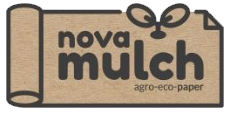
Specific characteristics.
Specifically designed to function in accordance with sustainability, this is an eco-friendly sheet of microperforated paper designed to cover the soil in horticultural and agricultural crops.
Made with 100% compostable natural cellulose fiber paper, free of inks, varnishes, synthetic glues, and polluting additives, and made with wood from sustainably managed forests (FSC certified).
Highly tear-resistant, with greater durability and rigidity, and fully biodegradable and compostable. Unlike generic recycled papers, it doesn’t disintegrate prematurely or require additional mulching with straw or compost to function properly.
Its biodegradation process occurs in approximately four to seven months, leaving no toxic residue or microplastic components, providing the necessary timeframe for achieving a healthy and highly productive crop.
The structure of this agricultural mulch allows the soil to breathe, keeping it in optimal condition throughout the planting cycle. Its purpose is to prevent the emergence and proliferation of resistant and invasive weeds such as sedge.
Novamulch mulch is designed with a light and dark side, allowing the soil surface temperature to be regulated according to the time of year:
- During periods of high temperatures, it is recommended to place the clear side upwards, as it reflects much of the solar radiation and helps keep the soil cooler.
- During periods of normal or low temperatures, the dark side facing up is the best option, because it absorbs more solar radiation, raising the soil temperature and promoting root development.
Novamulch creates the biodegradable paper mulch design with more operational and effective features:
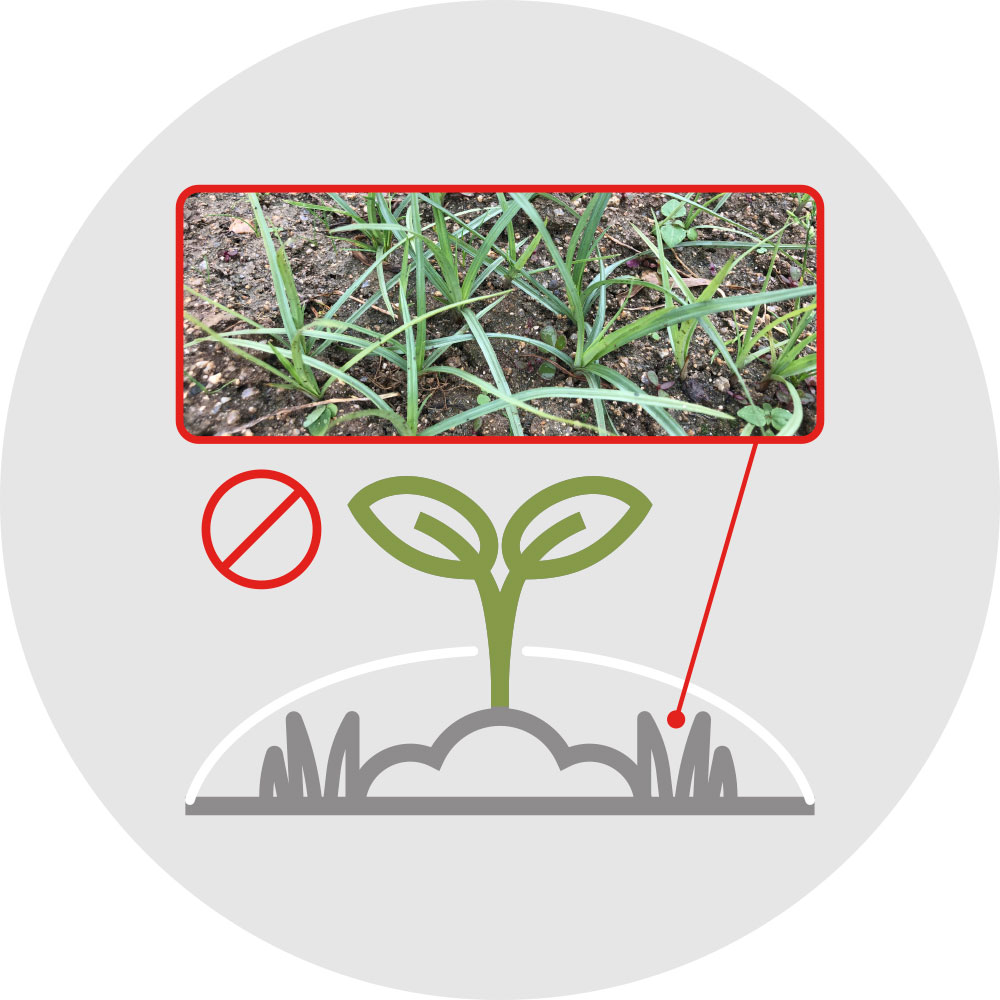
- Blocks the passage of sunlight, and is therefore an excellent UV ray blocker.
- It does not generate condensation or transpiration, thus maintaining a constant temperature that, on the one hand, suppresses the germination of unwanted seeds, and on the other, promotes the germination of the main seeds and the strengthening of seedlings, root development, and nutrient absorption.
- Thanks to its fibrous structure and natural coloring, it acts as a thermal insulator. Using this biodegradable paper agricultural mulch will prevent daytime overheating and heat loss at night, reducing evaporation without impeding gas exchange with the soil.
- Maintains humidity levels in balance.
- It adequately regulates soil temperature.
- It protects both the root system and essential soil nutrients from the climatic variables of the area where we plan our agricultural projects, thus achieving healthy, high-quality crops.
- It complies with biodegradability standards required by European regulations (such as EN 13432).
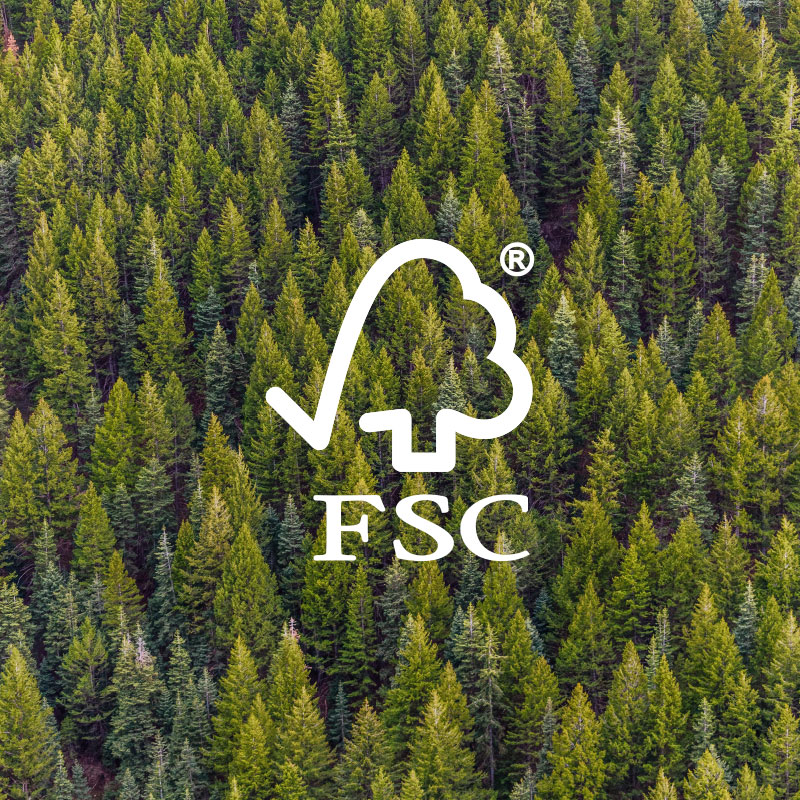
During periods of drought, in dry growing areas or with limited irrigation capacity, Novamulch biodegradable paper mulch protects our crops from water stress or soil breakdown, and guarantees us an approximate 20% to 40% water saving compared to traditional planting without mulching.
Another of its features is its adaptability to all growing environments. This means it can be spread over large areas in open fields, greenhouses, domestic and urban gardens, terraces, balconies, and pots, as its format and thickness are adapted to facilitate any planting area. It can be placed manually or mechanically.
As we have analyzed, Novamulch biodegradable paper mulch does not need to be removed either during or at the end of a sowing season:
- It biodegrades and is incorporated into the soil profile as a cellulosic fiber.
- It provides organic carbon to the soil, helping to improve its structure.
- Its water retention capacity and microbial activity guarantee improved operational sustainability for our agricultural projects, as well as significant savings in waste collection and management costs.
Experience in field trials shows us that, ultimately, these features and functions of Novamulch biodegradable paper mulch are intrinsically committed to sustainable agricultural practices, the use of renewable materials, and the absence of fossil polymers or synthetic additives:
- The use of compostable paper free of plastics, dyes, or chemicals, and made with wood from sustainably managed forests (FSC certified), aligns with responsible consumption and the circular economy.
- Field biodegradation occurs without plastic waste and supports healthy soil and agricultural ecosystems.
Buy your Novamulch biodegradable paper agricultural mulch here.
-
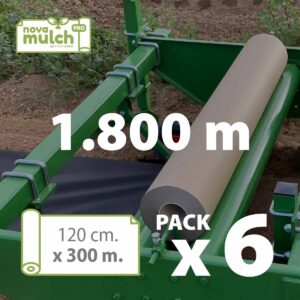 PACK of 6 rolls of Novamulch Professional paper 120 cm. x 300 m. (1.800 m)565,28 € IVA incluido
PACK of 6 rolls of Novamulch Professional paper 120 cm. x 300 m. (1.800 m)565,28 € IVA incluido -
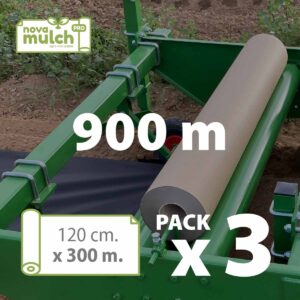 PACK of 3 rolls of Novamulch Professional paper 120 cm. x 300 m. (900 m)282,22 € IVA incluido
PACK of 3 rolls of Novamulch Professional paper 120 cm. x 300 m. (900 m)282,22 € IVA incluido -
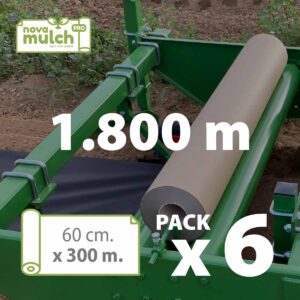 PACK of 6 rolls of Novamulch Professional paper 60 cm. x 300 m. (1.800 m)282,22 € IVA incluido
PACK of 6 rolls of Novamulch Professional paper 60 cm. x 300 m. (1.800 m)282,22 € IVA incluido -
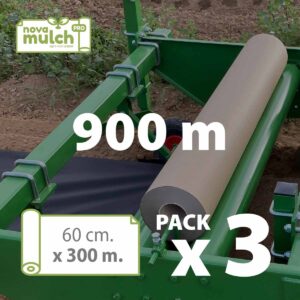 PACK of 3 rolls of Novamulch Professional paper 60 cm. x 300 m. (900 m)141,30 € IVA incluido
PACK of 3 rolls of Novamulch Professional paper 60 cm. x 300 m. (900 m)141,30 € IVA incluido -
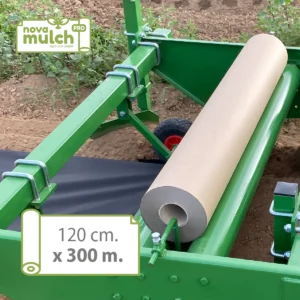 Novamulch Professional Paper 120 cm. x 300 m.94,21 € IVA incluido
Novamulch Professional Paper 120 cm. x 300 m.94,21 € IVA incluido -
 Novamulch Professional Paper 60 cm. x 300 m.47,10 € IVA incluido
Novamulch Professional Paper 60 cm. x 300 m.47,10 € IVA incluido -
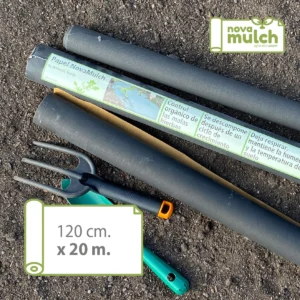 Novamulch paper 120 cm. x 20 m.41,63 € IVA incluido
Novamulch paper 120 cm. x 20 m.41,63 € IVA incluido -
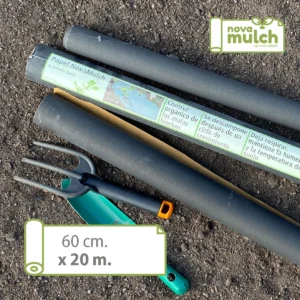 Novamulch paper 60 cm. x 20 m.21,89 € IVA incluido
Novamulch paper 60 cm. x 20 m.21,89 € IVA incluido -
 Novamulch paper 60 cm. x 10m.14,85 € IVA incluido
Novamulch paper 60 cm. x 10m.14,85 € IVA incluido -
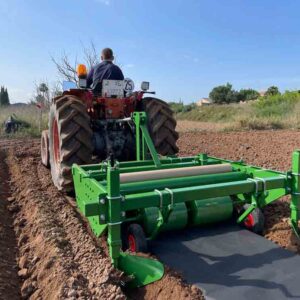 Novamulch agricultural mulching machine
Novamulch agricultural mulching machine
What is the best agricultural mulch for organic crops?

When we decide to create a sustainable and environmentally friendly agricultural roadmap, we must take several key points into consideration. Let’s study.
In organic farming, implementing the use of agricultural mulch is essential to coordinate the protection of soil nature, the conservation, and the conscious use of the resources at our disposal. It must fulfill a broader function: being an active part of the ecosystem, not a burden on it. We will explore this below.
In organic farming, implementing the use of agricultural mulch is essential to coordinate the protection of soil nature, the conservation, and the conscious use of the resources at our disposal. It must fulfill a broader function: being an active part of the ecosystem, not a burden on it. We will explore this below.
- Preventing and inhibiting the growth and proliferation of weeds without the use of chemical herbicides, thereby reducing labor costs for weeding, harvesting or replacing equipment, and maintenance.
- Reduction of water evaporation, significantly promoting water savings of between 20% and 40%.
- Maintaining a balanced thermal balance in soils, protecting the root system and vegetative growth from unexpected temperature and climate changes. It also improves the quality and flavor of food.
- Reduction of the risk of erosion, compaction, leaching and loss of essential nutrients in the soil structure.
- It does not allow direct contact with the upper structure of plants (stems, leaves, flowers and fruits), thus preventing deterioration (rot, necrosis, fungi and diseases) due to continuous humidity.
- Being biodegradable and made with 100% compostable paper from sustainably managed forests, free of inks, plastics, synthetic glues, or varnishes, Novamulch biodegradable paper mulch integrates into the soil as organic matter without leaving polluting residues or requiring additional industrial degradation procedures.
- It is a highly tear-resistant material, making it compatible with all types of crops and environments, without the need for additional cover.
- Its breathable structure prevents condensation, transpiration, or overheating of the soil.
What is the best agricultural mulch for conventional crops?
Specifically, the main requirements for conventional crops lie in achieving a balance between yield, sustainability, and profitability. Production efficiency and cost control are key factors, which is why the use of agricultural mulch is a necessary and widespread practice.
We’ve already studied the characteristics and functions of both organic and inorganic agricultural mulch, as well as the biodegradable paper mulch, Novamulch. However, the latter has emerged as the best alternative among all types of agricultural mulch, thanks to its multiple agronomic, economic, and environmental benefits.
General conclusion and final reflections.

When we decide to create an agricultural project, we learn that there are multiple variables that are essential to successfully navigate our roadmaps.
One of these variables is choosing the type of crop we want to undertake, whether it will be conventional or sustainable. In this step, we must analyze the scope we can achieve in terms of productivity and optimal quality in the final results.
And in this step, it’s important to prioritize the budget we have available to start our agricultural roadmap, the environment in which we’ll establish the crop, and conduct field research on the results of crops grown under both traditional and organic schemes.
Even today, it is often thought that investing in sustainable crops means higher costs than traditional crops… nothing could be further from the truth…
As we saw in this agricultural section, when taking stock of the overall costs and results, we realize that if we opt for an organic system, implementing Novamulch biodegradable paper mulch, the cost balance leans in our favor because, from the start of our crops, we will make a single expenditure of a material that will cover all variables and potential unforeseen events until harvest time.
We won’t be forced to remove waste and renew it periodically, as is the case with polyethylene agricultural mulch, which is much more expensive and doesn’t provide the profitability we had planned.
The same will happen if we use organic agricultural mulch, as we must renew it in short periods of time, assuming the risk of generating pests and diseases, as well as deterioration due to sunlight hitting the gaps left uncovered.
Thus, the analysis conducted on this occasion, in our Novamulch agricultural space, shows us the possibility of choosing healthy planting methods that fit our budget and guarantee optimal quality and profitability of our products.


